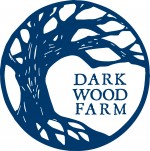I spend a lot of time sharing news about the farm and the farming process, but I haven’t been too good about sharing homesteading stories. Part of the reason I decided to become a farmer and live on my farm is because I like growing and preserving my own food. Mainly because I love to eat and eat well. When I first moved onto the farm this winter, I decided to try tapping some of the maple trees on the property to make my own maple syrup. I ended up tapping three trees and got enough syrup to keep my pancakes topped throughout the year, with a few jars of syrup to spare to give as gifts to my family. Currently, the veggies and fruit are rolling in, and it seems like I can’t find enough spare time to do all the canning I’d like. Plus, my gas stove heats the kitchen up sooo much that I’ve convinced myself I’ll do all my pickling and canning when the fall comes and I can use the extra heat in the kitchen. For now, most of the food preservation I have been doing involves drying herbs. I can deal with the heat that the dehydrator puts off, plus I’ve been passively drying a bunch of herbs by hanging them upside down from a curtain rod in the kitchen. Any extra bunches of basil, tulsi, and coriander that I bring home from the market go right up on the “drying rod” until they are crispy dry, then I strip the leaves or seeds off the bunches and store them in a dry mason jar. It makes me excited for spices and tea this winter when my garden is under lots of snow.

Earlier this week, I harvested a crop of mustard seeds from the garden. In April, I planted white mustard, Sinapis alba, which is used to make the table mustard we’re all used to eating. Your basic mustard comes from grinding down the seeds of this plant, and adding it to water, vinegar, or other liquids and spices. For example, dijon mustard typically includes white wine as one of the liquids. Additionally, the super yellow color we normally associate with mustard comes from the addition of turmeric, although I’m sure a lot of cheap store-bought mustard just uses food dyes these days. You can also use seeds from other mustard plants to make different kinds of mustard. In the past, I have grown brown mustard, Brassica juncea, and used it to make spicy brown mustard.
After the initial April planting of white mustard, the plants grew quite quickly and were in full flower by the end of May. And, boy, did the bugs love those flowers. It was a veritable bug orgy down there in the mustard patch.

Slowly, the flowers turned into green seed pods that plumped up and filled with green seeds. Then, the seed pods began to dry up, turn brown, and the seeds inside turned from green to tan/yellow. A few days ago, while the weather was dry, I decided that the majority of the mustard plants were dry enough, and that I should harvest them before they shattered, which happens when the plant gets so dry that the pods burst open and spew their seeds all over the ground.


To harvest the seed, I cut down handfuls of the plants, and shook them into a large, clean garbage can, causing the seed pods to shatter and release their seeds. This process is called threshing. It took me 2 hours to thresh 250 square feet of densely growing mustard. A mechanical harvester would be a whole lot quicker, but I don’t have a mechanical harvester, and I enjoy spending time in the garden doing repetitive work. It lets me relax, listen to the birds, and let my thoughts wander. At the end of the two hours, I had a can of mustard seeds and shattered seed pods, and I left the remains of the mustard plants, or “straw”, behind to compost back into the soil.


When I finished the threshing process, I brought my garbage can of seeds and pods to my kitchen and sifted it all through a strainer to separate out the seeds from the pods. There is still a little bit of chaff, or non-seed material, in with the seeds, so on the next low humidity day, I will take them outside with a fan and pour the seeds into a bucket in front of the fan to let the lightweight chaff blow off. All in all, I will have around 4 lbs of mustard seed, which I will use to make mustard, spice up dishes, and to make my new favorite condiment, pickled mustard seed, or “mustard caviar.” It’s a whole lot more work than buying mustard at the store, but at the end of the day, I love that my mustard will be homegrown, and the mustard patch was a huge benefit to the garden. It provided habitat for all kinds of beneficial insects during the flowering stage, its straw will help feed the soil, and because it was such a dense stand of tall plant material, it helped to keep weeds from sprouting underneath. Also, recent research has shown that growing mustard as a cover crop helps to fend off some of the pest insects and nematodes that live in the soil. All of that is wonderful, but honestly, I’m most excited about tasting my homemade mustard because, like I said, I love to eat.




